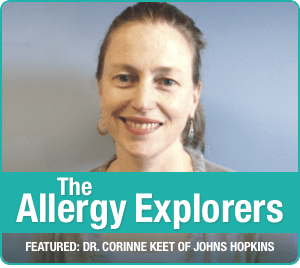
Keet is a prolific researcher, investigating everything from nutrition in food-allergic children to food allergy treatments, and allergy and asthma in inner-city neighborhoods
In our “Allergy Explorers” series at Allergic Living, we honor researchers who are diligently trying to solve the allergy puzzle. Keet says she’s motivated to do her research by the patients she sees in her clinic – and we’re inspired by her desire to understand allergic disease and find a safe and effective treatment.
Contributing Editor Claire Gagné spoke to allergist Corinne Keet about her current research, her personal connection to the disease, and what it was like to cast doubt on the effectiveness of OIT.
How did you become interested in food allergies?
Corinne Keet: I went into allergy and immunology thinking I would focus on immunodeficiencies, but I was drawn to food allergy because so many people are affected and so little is known compared to a lot of other fields in medicine. For example, we don’t know why some people develop allergies while others don’t, and we still don’t have good treatments for the disease.
I also do have a personal connection – I was allergic to eggs as a child, so allergy was something I thought about from a young age. Fortunately, my allergy was mild, especially compared to what I see in my practice. And I grew out of it by the time I was a teenager.
Where did you study allergy and immunology?
CK: I have been at Johns Hopkins for 11 years; I came to do my pediatric training, stayed for allergy training and then got on as faculty.
What are you currently working on in your research?
CK: Right now I’m working on trying to understand trends in food allergy over time; who is most affected, do blood markers of food allergy (i.e. IgE testing to foods) match trends in self-reported allergy, and why does food allergy seem to be so common now?
It’s a large amount of data – I’m looking at stored samples from large national surveys, and there are approximately 7,000 samples. This research hasn’t been published yet, so I can’t comment on the findings.
You’ve done considerable research on oral immunotherapy (OIT) and sublingual immunotherapy (SLIT). What interesting things are you finding out about these two potential allergy treatment methods?
CK: We did a few studies directly comparing OIT and SLIT for milk and peanut allergy and found that SLIT was much less effective than OIT, but that there were more side effects with OIT. This was interesting because before this scientists had done research on each of these treatments individually, but hadn’t compared the treatments in the same group of people. Our results suggest that, at least as has been seen in the research thus far, SLIT is a less promising treatment.
You have published a study that called the long-term effectiveness of OIT into question. Did you feel like you were dashing everyone’s hopes for a cure?
CK: After our original studies of OIT for milk allergy, we knew this treatment wasn’t yet ready to be used in general allergy practice for safety reasons, but we thought that many patients would come out of OIT ready to put their allergies behind them.
After several more years, some patients were doing really well after completing the therapy, with milk in their diets without problems. But many were still having some problems with milk; reactions every now and then, or feeling terrible if they consumed too much dairy at one time. Only 25 percent were consuming milk without symptoms, whereas 38 percent had frequent or predictable symptoms, and 16 percent were not consuming milk at all. For most patients, they were able to tolerate more milk, but the allergy was still there.
This was disappointing, but I think it’s really important that these therapies are rigorously evaluated before being adopted in the community. These treatments are not low risk, and it’s essential that we understand the benefits and the risks. I know people are anxious for a treatment, but there are dangers in rushing into things.

Keet’s current focus is looking into why the prevalence of allergies is growing. Today, 1 in 13 American children has an allergy.
How do you foresee food allergy being treated 5 years from now? Or 10 years from now?
CK: The honest answer is that I don’t know how food allergy will be treated in five or 10 years from now. I hope we have developed methods of treating food allergy that are safe and effective – these methods may incorporate OIT, but they may not. It may also end up being the case that there is not a single treatment for everyone, but that we have more personalized treatments based on biomarkers or other risk profiles.
Personally, I’m interested in hearing more about the results of the allergy patch trials (I’m not involved in that research), and in seeing how immunotherapy might be combined with other medications or compounds to either increase the effectiveness or decrease side effects.
You have also been involved in research that has looked at the growth of kids with food allergies. Is this a big concern?
CK: Many allergies, such as peanut and tree nut allergy, don’t have a major impact on nutrition. However, milk allergy, in particular, can affect children’s growth because milk and milk products are such a big part of the typical U.S. child’s diet. For kids with milk allergy, it is important to make sure they are getting enough protein, calories, vitamin D and calcium.
You recently published a paper that found that the high prevalence of asthma in inner-city neighborhoods is a result of demographics and not actually from living in an urban environment. What is the relevance of that research?
CK: I was applying for a grant and I was trying to put in a sentence about the prevalence of asthma in inner-city neighborhoods across the United States, and I couldn’t find a number. I started to look into it more and I and realized that this hadn’t been described across the U.S.
So we did a study and we found that living in a city wasn’t a risk factor, per se, for having asthma, but that being poor or being of Black race or Puerto-Rican ethnicity were strong risk factors for having asthma, regardless of where you lived.
The study didn’t focus on whether living in a city made your asthma worse; we are looking at that now. I think the relevance of this research to public health is that we need to make sure we understand that asthma is found everywhere, and that we look into the factors that contribute to developing asthma across the U.S., not just in inner cities.
Did you also looked at allergy in inner-city neighborhoods?
CK: We did look at food allergy in a parallel project; that paper will be published soon in the Annals of Allergy, Asthma and Immunology. I can’t comment on the findings just yet.
2015 Honorees in The Allergy Explorers Series:
- Dr. Ying Song: Inside the Search for Chinese Herbal Food Allergy Treatments
- Dr. Brian Vickery – The MD Training Baby’s Immune System Not to be Allergic





